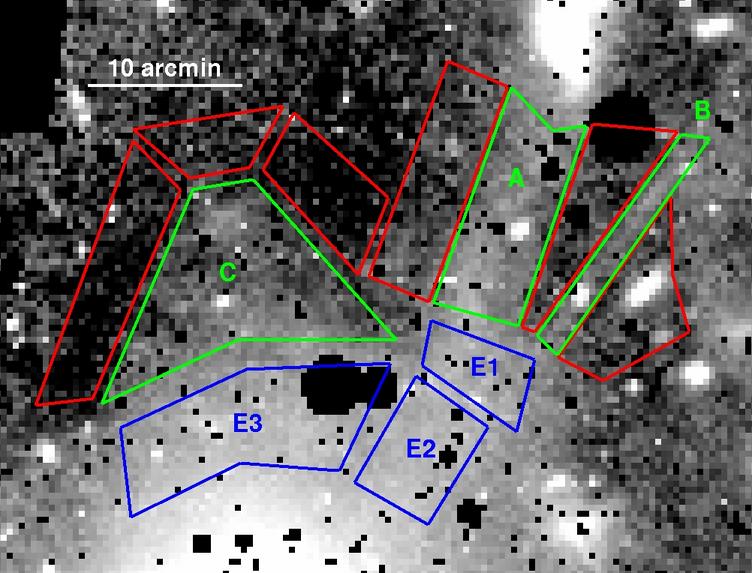This work has been made possible by funding from the National Science Foundation and from the Sigma Xi GIAR program.
Since 2005, I have been working on the ongoing deep imaging survey of the Virgo cluster using the CWRU-owned-and-operated Burrell Schmidt telescope located at Kitt Peak. The observational team includes my advisor Chris Mihos, Paul Harding, John Feldmeier, Steven Janowieki, Heather Morrison, and a number of CWRU undergrads.
I have been heavily involved in all the observing since 2005, but my primary focus has been on re-imaging the cluster core in the B-band so we can measure B-V colors of the ICL features. We just finally got this data in the 2009 observing season. In previous seasons, we have been extending the survey to cover other areas of the Virgo cluster, including the M49 group.
Virgo Cluster Core
Below is our extremely deep image of the Virgo cluster core in the V-band, from Mihos et al. 2005 (I was not actually on the observing team at the time this data was taken). M87, the cluster cD, is the big elliptical in the lower left, and M86 and M84 are the two giant ellipticals on the right. To the right image of the same piece of sky from the Sloan Digital Sky Survey that I grabbed from their navigate tool . In our image, there are an incredible number of extremely faint streamers, tails, plumes and other features which permeate this image, which give us a lot of otherwise inaccessible information on the dynamics of the cluster galaxies.

|

|
ICL Colors
Now that we've got the B-band data for this field, and I am currently spending almost all of my time working on measuring colors for some of the very faint ICL features seen in the above image. Below is a closer view of the area just to the north of M87, containing a number of interesting tidal features. In order to measure colors, we use a differential photometry method where we measure the flux of the streams themselves (green boxes, labeled A, B, and C, respectively) and subtract the local background flux (red boxes). We can also use this method to measure the color of M87's outer stellar envelope itself (blue boxes, labeled E1, E2, and E3).

|
A: B-V ~ 0.75-1.05 B: B-V ~ 0.8-1.2 C: B-V ~ 0.7-1.0 E1 B-V ~ 0.8-0.9 E2: B-V ~ 0.75-0.85 E3: B-V ~ 0.75-0.85 |
mu_V ~ 28.6 mag. / sq. arcsec mu_V ~ 29.2 mag. / sq. arcsec mu_V ~ 28.7 mag. / sq. arcsec mu_V ~ 28.2 mag. / sq. arcsec mu_V ~ 27.7 mag. / sq. arcsec mu_V ~ 27.6 mag. / sq. arcsec |
While the measured colors have large uncertainties due to systematic errors at these very low surface brightnesses, our results suggest that the colors of the ICL features are similar to those of M87's outer stellar envelope. We interpret this as suggesting that the outer stellar envelope of cD galaxies, such as M87, may be generated by the tidal disruption of orbiting satellites, initially create tidal streams which later dissolve to form a smooth, low-surface brightness envelope.
Other Results
B-Band image of the cluster core.Galactic Cirrus - 100 micron IRAS map from Schlegel et al. (1998).
Substructure in M49.
Papers
- Optical Colors of Intracluster Light in the Virgo Cluster Core. Rudick, C.S., Mihos, J.C., Harding, P., Feldmeier, J.J., Janowiecki, S. & Morrison, H.L., ApJ, 720, 569. astro-ph
- Diffuse Substructure in the Stellar Envelopes of Virgo Ellipticals. Janowiecki, S., Mihos, J.C., Harding, P., Rudick, C.S., Feldmeier, J.J., & Morrison, H.L., ApJ, 715, 972. astro-ph
I often have a lot of time to kill while out at the Schmidt, when the moon is up, with thin cloud cover, or before/after Virgo rises/sets. During that time, I have taken dozens of pretty pictures of interesting astronomical objects, which you can find over in my pretty pictures gallery.
Homepage
Last modified: Wed Aug 22 09:53:50 CEST 2012